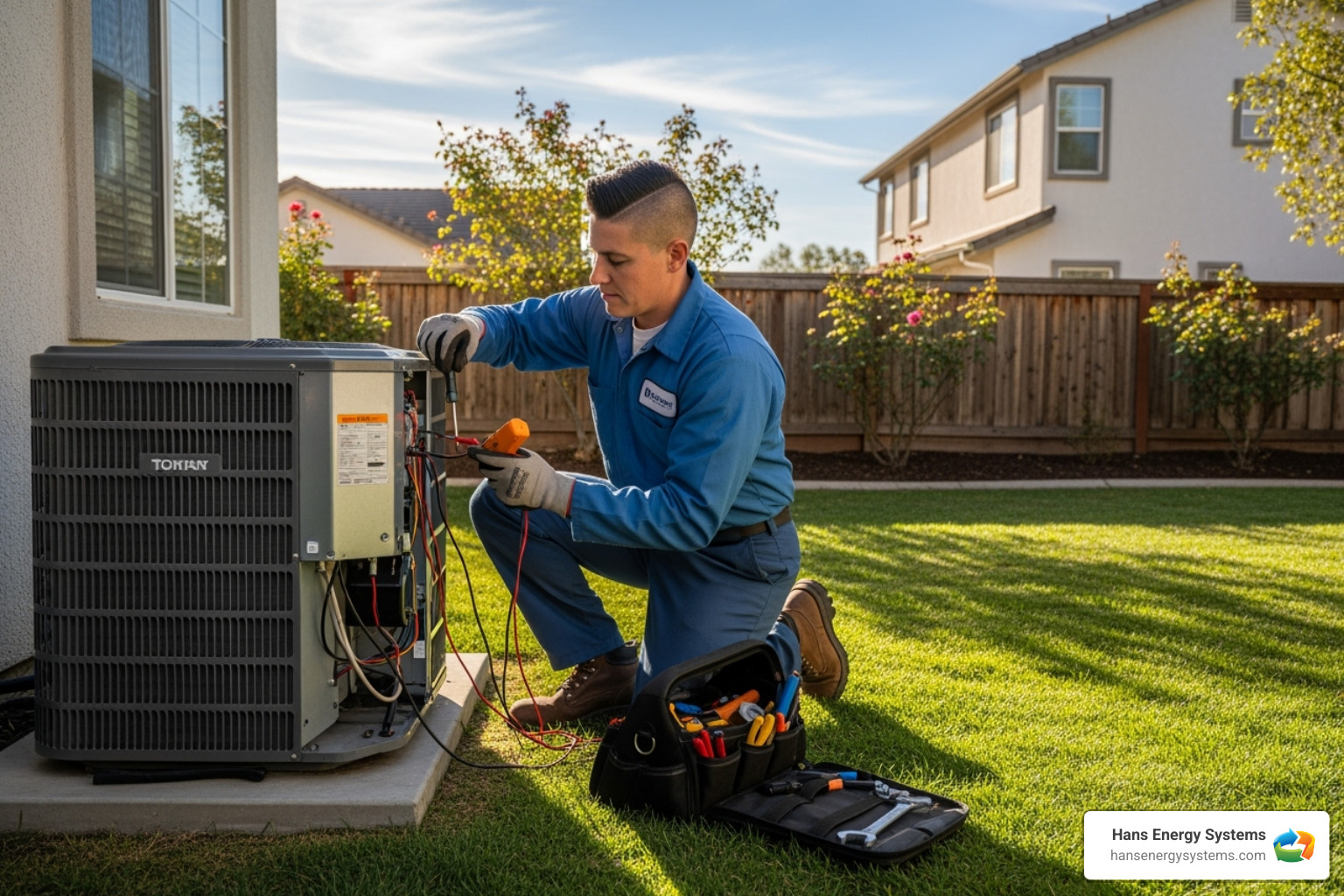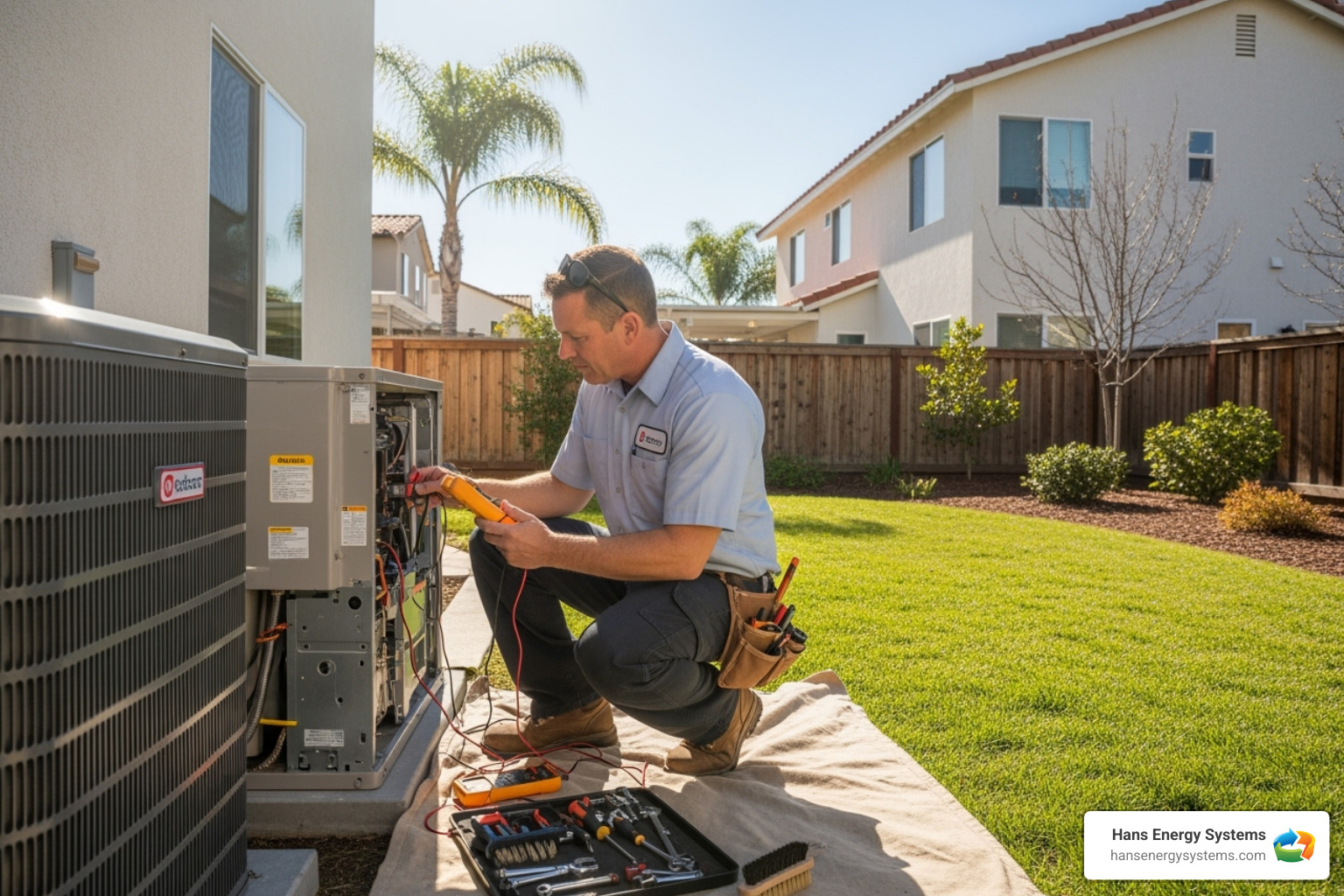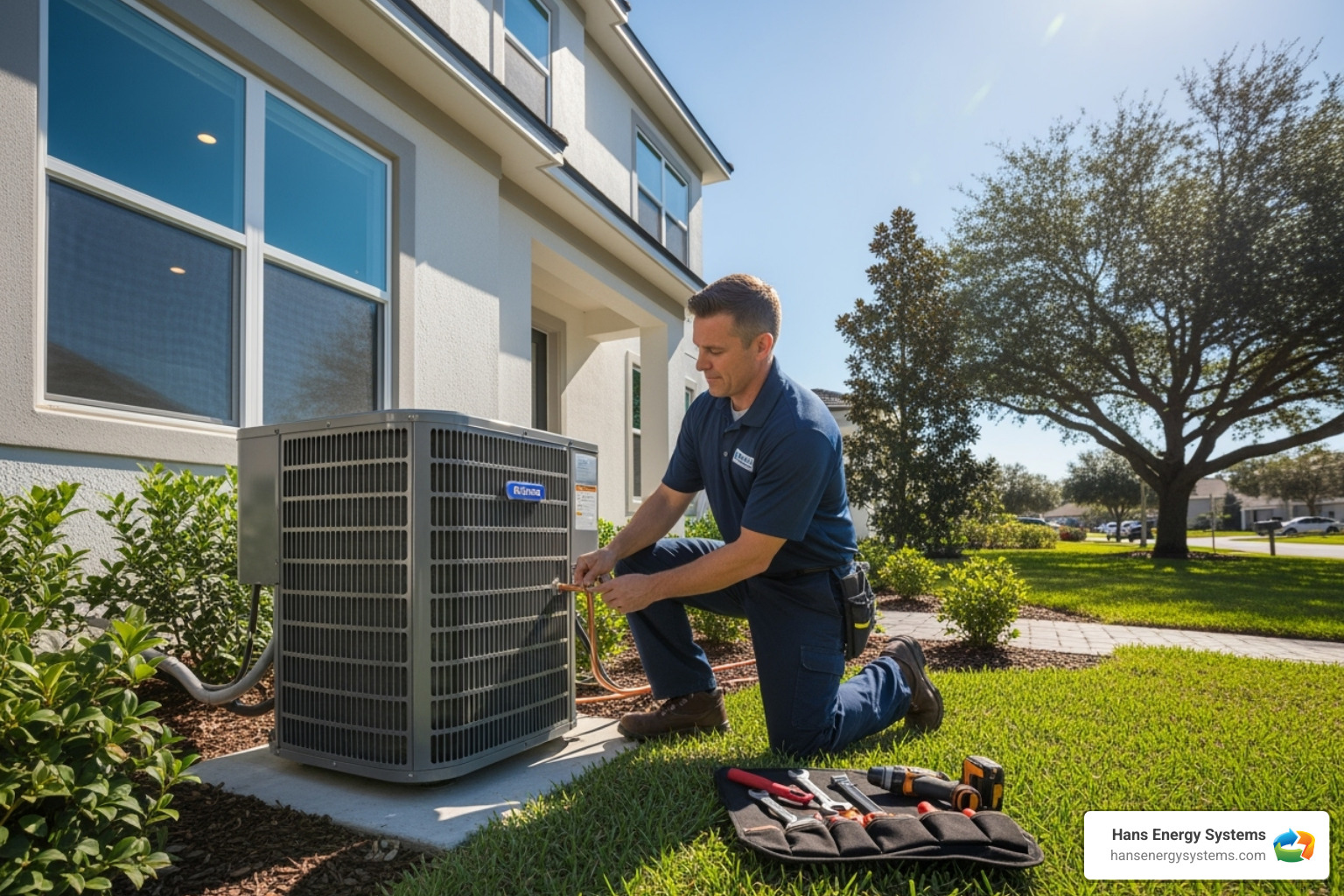Why Tesla Model 3 Home Charging is a Game-Changer
Tesla model 3 home charger installation transforms how you power your electric vehicle, offering best convenience and significant cost savings. Instead of hunting for public charging stations or paying premium rates, you can simply plug in at home and wake up to a fully charged battery every morning.
Quick Answer: Tesla Model 3 Home Charger Installation Steps
- Choose your charger: Mobile Connector (portable, up to 30 mph) or Wall Connector (fastest, up to 44 mph)
- Assess electrical needs: Check if your home panel can handle 240V/40-50 amp circuit
- Get permits: Required for most installations to ensure code compliance
- Hire certified installer: Professional installation ensures safety and warranty coverage
- Connect and test: Installer will commission the system and verify proper operation
Home charging delivers multiple benefits that make the investment worthwhile. You’ll save money by charging during off-peak hours when electricity rates are lowest – often 50-70% cheaper than daytime rates. The convenience factor is huge too. As one Tesla owner put it: “never worrying about gas prices again, charging your tank while you sleep and skipping out on oil changes sounds nice.”
Cost savings add up quickly. Home charging typically costs 3-5 times less than public charging stations. Plus, you’ll increase your property value while reducing your carbon footprint, especially when paired with solar panels.
The installation process is straightforward when you work with certified professionals. Most homes can accommodate a Tesla charger with minimal electrical upgrades. The Wall Connector adds up to 44 miles of range per hour, while the Mobile Connector provides up to 30 miles per hour – both easily meeting daily driving needs for most people.
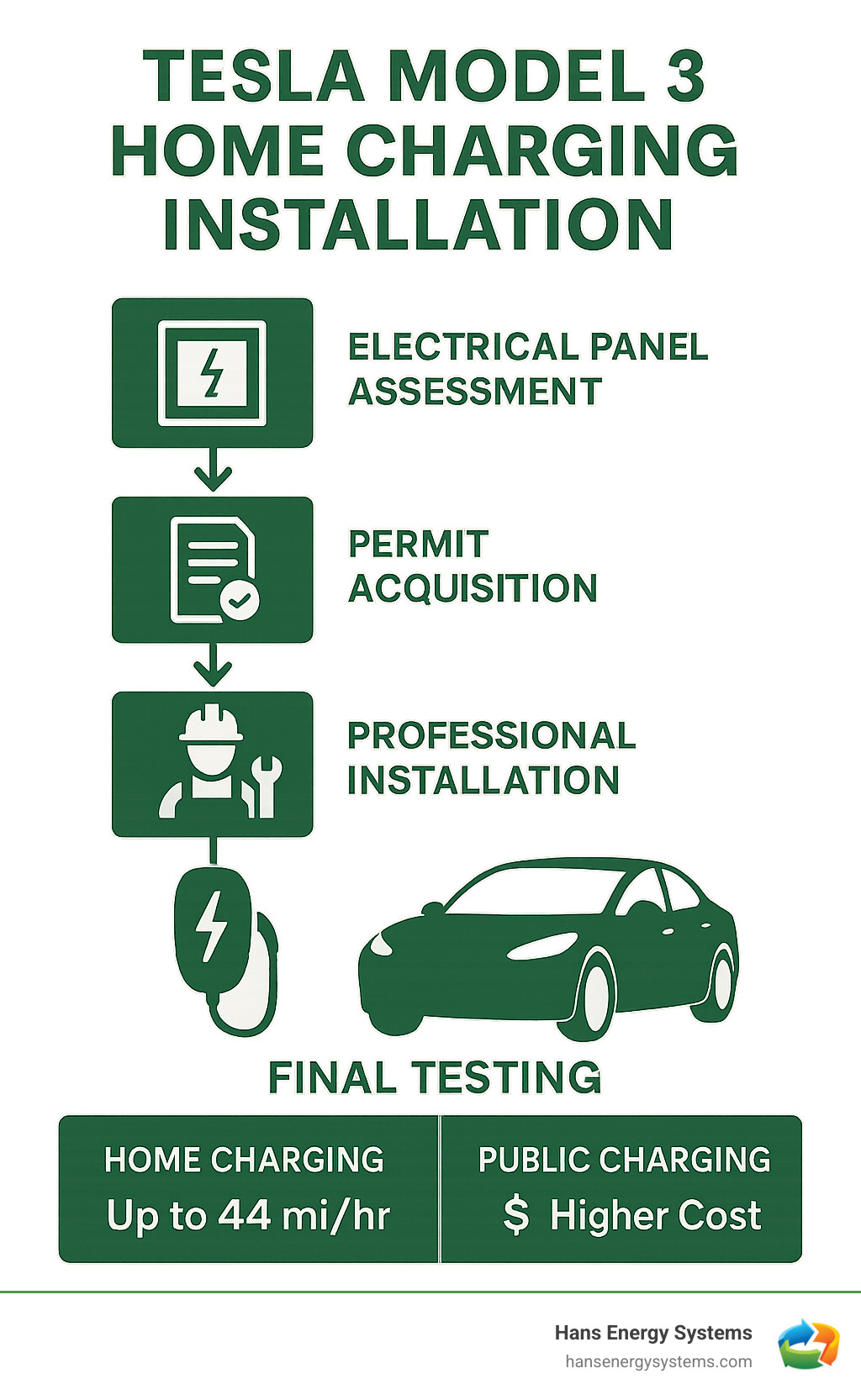
Choosing Your Tesla Home Charger: Mobile vs. Wall Connector
When you’re ready to start your tesla model 3 home charger installation, the first big decision is picking the right charging equipment. It’s kind of like choosing between a Swiss Army knife and a professional tool – both get the job done, but in different ways.
Tesla offers three main charging options for your home: the Mobile Connector, the Wall Connector, and the Universal Wall Connector. Each has its own personality, if you will. The Mobile Connector is your flexible friend who’s ready for anything. The Wall Connector is your reliable homebody who delivers consistent performance. And the Universal Wall Connector? That’s your future-thinking option that plays well with all EVs.
Here’s how they stack up:
| Feature | Mobile Connector | Wall Connector | Universal Wall Connector |
|---|---|---|---|
| Purchase Price | Lower cost option | Mid-range investment | Premium choice |
| Installation Cost | Minimal to moderate (if 240V outlet needed) | Professional installation required | Professional installation required |
| Charge Speed (mph) | 3-30 mph depending on outlet | Up to 44 mph | Up to 44 mph |
| Cable Length | 20 feet | 24 feet | 24 feet |
| Best For | Portability, budget-conscious, existing 240V outlet | Dedicated home charging, smart features | Multi-EV households, future-proofing |
Something worth knowing: your Model 3 Rear-Wheel Drive and Model Y Rear-Wheel Drive max out at 32 amps for AC charging. So while the Wall Connector can push 48 amps, your Tesla will only drink what it can handle. Think of it like having a fire hose when your car only needs a garden hose – but there are still plenty of other benefits to the Wall Connector.
Mobile Connector: The Portable Solution
The Mobile Connector is like having a charging station that fits in your trunk. It’s the chameleon of Tesla chargers, adapting to whatever outlet you can find.
Plug it into a regular household outlet (120V), and you’ll get about 3 miles of range per hour. That might sound slow, but if you’re only driving short distances or have all night to charge, it can work perfectly fine. It’s like slow-cooking your battery – gentle and steady.
The magic happens when you step up to a 240V outlet with the right adapter, especially the NEMA 14-50 adapter (the same type used for electric dryers or RV hookups). Suddenly, you’re adding up to 30 miles of range per hour. That’s enough to fully charge most daily driving needs overnight.
The portability benefits are huge. Going to visit family? Bring your charger. Taking a road trip to a vacation rental? Your Mobile Connector comes along. Plus, there’s a lower upfront cost since you’re not paying for a permanent installation – assuming you already have a 240V outlet where you park.
Ready to go portable? You can Order Mobile Connector directly from Tesla.
Wall Connector: The Fastest & Smartest Option
If the Mobile Connector is your travel buddy, the Wall Connector is your best friend at home. This is the premium tesla model 3 home charger installation option that most Tesla owners fall in love with.
First, let’s talk speed. The Wall Connector delivers up to 44 miles of range per hour. That means even if you come home with a nearly empty battery, you’ll wake up fully charged. It’s like having your own personal gas station that works while you sleep.
But speed is just the beginning. The Wall Connector is Wi-Fi enabled, which opens up a whole world of smart features. It receives over-the-air updates, so your charger actually gets better over time – just like your Tesla. How cool is that?
The smart features really shine through the Tesla app integration. You can schedule charging for off-peak hours, monitor your energy usage, and even control access if you want to share your charger with guests. If you’re planning a multi-EV household, the power sharing for multiple EVs feature lets two Wall Connectors intelligently share power from a single circuit.
And let’s be honest – the sleek design looks fantastic mounted on your garage wall. It’s the kind of tech that makes you feel like you’re living in the future.
The Universal Wall Connector offers all these same benefits but works with both Tesla and non-Tesla EVs. It’s perfect if you’re thinking about diversifying your EV collection down the road.
Ready for the premium experience? Order Wall Connector and take your home charging to the next level.
The Step-by-Step Tesla Model 3 Home Charger Installation Process
Getting your tesla model 3 home charger installation done right is straightforward with certified professionals. While every home is different, the process follows a proven path to ensure safety and optimal performance.
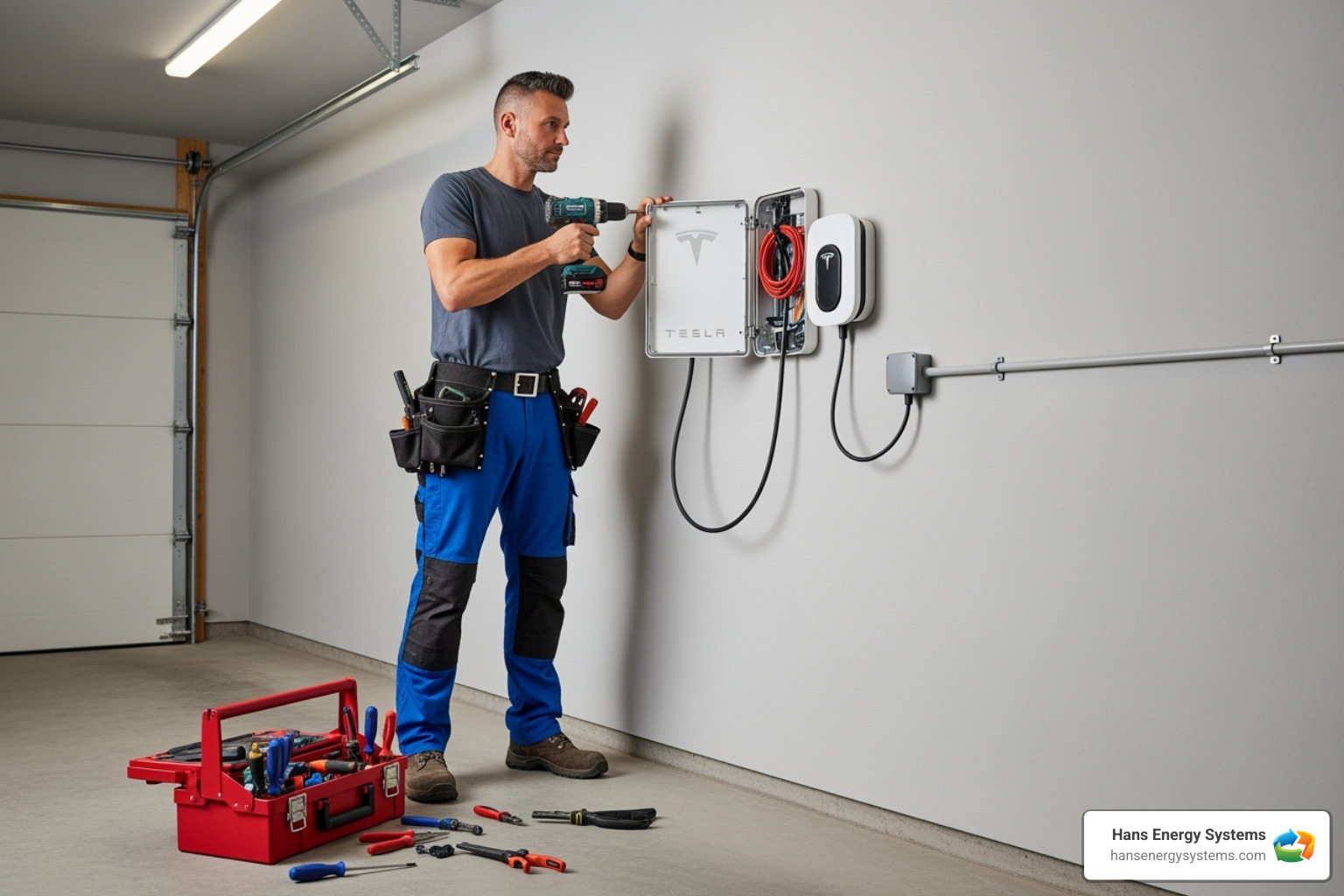
The process starts with a site assessment and electrical panel check. A certified electrician will assess your panel’s capacity and find the best spot for your charger. They’ll confirm if your system can handle the required 240V, 40-50 amp circuit and identify if any panel upgrades are needed.
Next is the permitting process. Most installations require a permit, which your electrician typically handles. This ensures your tesla model 3 home charger installation meets all local electrical codes and safety standards.
During the wiring and mounting phase, your electrician runs wiring from the panel to the charger location. The Wall Connector’s design simplifies this with an open wire box and flexible wire entry.
Finally, during commissioning and testing, the electrician uses the Tesla One app to connect the Wall Connector to Wi-Fi, set the circuit breaker rating, and configure amperage. They’ll then test it with your Tesla to ensure it works perfectly.
Key Considerations for Your Tesla Model 3 Home Charger Installation
Before any installation begins, there are several important factors that can make or break your charging setup. Understanding these upfront helps avoid surprises and ensures you get the best possible results.
Your home electrical system capacity is foundational. Your electrical panel needs enough spare capacity to handle an EV charger’s additional load. A Tesla Wall Connector typically needs its own dedicated 240V circuit with a 40A or 50A circuit breaker. If your panel is already maxed out or simply too old, you might need a main panel upgrade. Don’t worry though – we offer Financing Options in Poway, CA to make these upgrades more manageable.
Circuit breaker requirements depend on what you’re trying to achieve. For Tesla Model 3 RWD and Model Y RWD owners, a 40A circuit breaker works great for 32A output, which matches your car’s maximum charging rate. If you want the full 48A output for other Tesla models or future-proofing, you’ll need a 50A or 60A breaker.
Proximity to your parking space matters more than you might think. The closer your charger is to both your electrical panel and your Tesla’s charging port, the simpler and less expensive the installation becomes. Tesla recommends keeping the charger within 15 feet of your vehicle’s charge port for optimal convenience.
Sometimes main panel upgrades become necessary, especially in older homes or those already running close to capacity. This ensures your electrical system can safely handle your new EV charger alongside all your existing appliances without any issues.
For the technical details, you can Download the official installation manual that covers all the specifications and installation guidelines your electrician will follow.
DIY vs. Professional Tesla Model 3 Home Charger Installation
The DIY approach to your tesla model 3 home charger installation can be tempting to save money. However, unless you’re just plugging a Mobile Connector into an existing, appropriate 240V outlet, this is a job for professionals.
Safety risks with high-voltage work are significant. EV chargers use high-voltage circuits that are dangerous for anyone but a licensed electrician, with risks including shock, fire, and electrical system damage. It’s not worth the risk.
Local electrical codes and NEC compliance are complex. These regulations prevent hazards, and professional electricians ensure your installation meets every requirement, avoiding issues with permits or insurance.
The benefits of hiring a professional are numerous. They provide expert assessment, recommend the best setup, and handle all permitting. Professional installation also protects your Tesla warranty, which can be voided by improper installation.
Professionals also provide a workmanship warranty for peace of mind. A correctly installed charger performs better, delivering optimal charging speeds so your Tesla is always ready.
Tesla recommends working with certified installers. For your tesla model 3 home charger installation, choosing a professional isn’t just about convenience – it’s about ensuring everything works safely and efficiently for years to come.
Understanding Costs and Open uping Savings
When planning your tesla model 3 home charger installation, understanding the investment helps you make the best decision for your home and budget. The good news? While there are upfront costs, the long-term savings make this one of the smartest investments you can make for your Tesla.
The hardware costs vary depending on which charger you choose. Beyond the equipment itself, installation costs typically range from $750 to $1,500, though this can vary based on your specific situation.
Several factors influence your final installation price. Wire run distance plays a big role – the farther your charger location is from your electrical panel, the more materials and labor you’ll need. If you’re planning an outdoor installation or have a detached garage, trenching for underground wiring can add to the project cost.
Panel upgrades represent the most significant potential expense. If your home’s electrical system needs updating to handle your new charger safely, this investment protects your home and ensures optimal performance. The complexity of your electrical work also matters – older homes or unique layouts sometimes require creative solutions that take additional time and materials.
Despite these upfront costs, your tesla model 3 home charger installation pays for itself through incredible savings. Home charging typically costs 3-5 times less than public charging stations. Even better, many utility companies offer time-of-use rates where electricity is cheapest during off-peak hours – usually nights and weekends when you’d naturally be charging anyway.
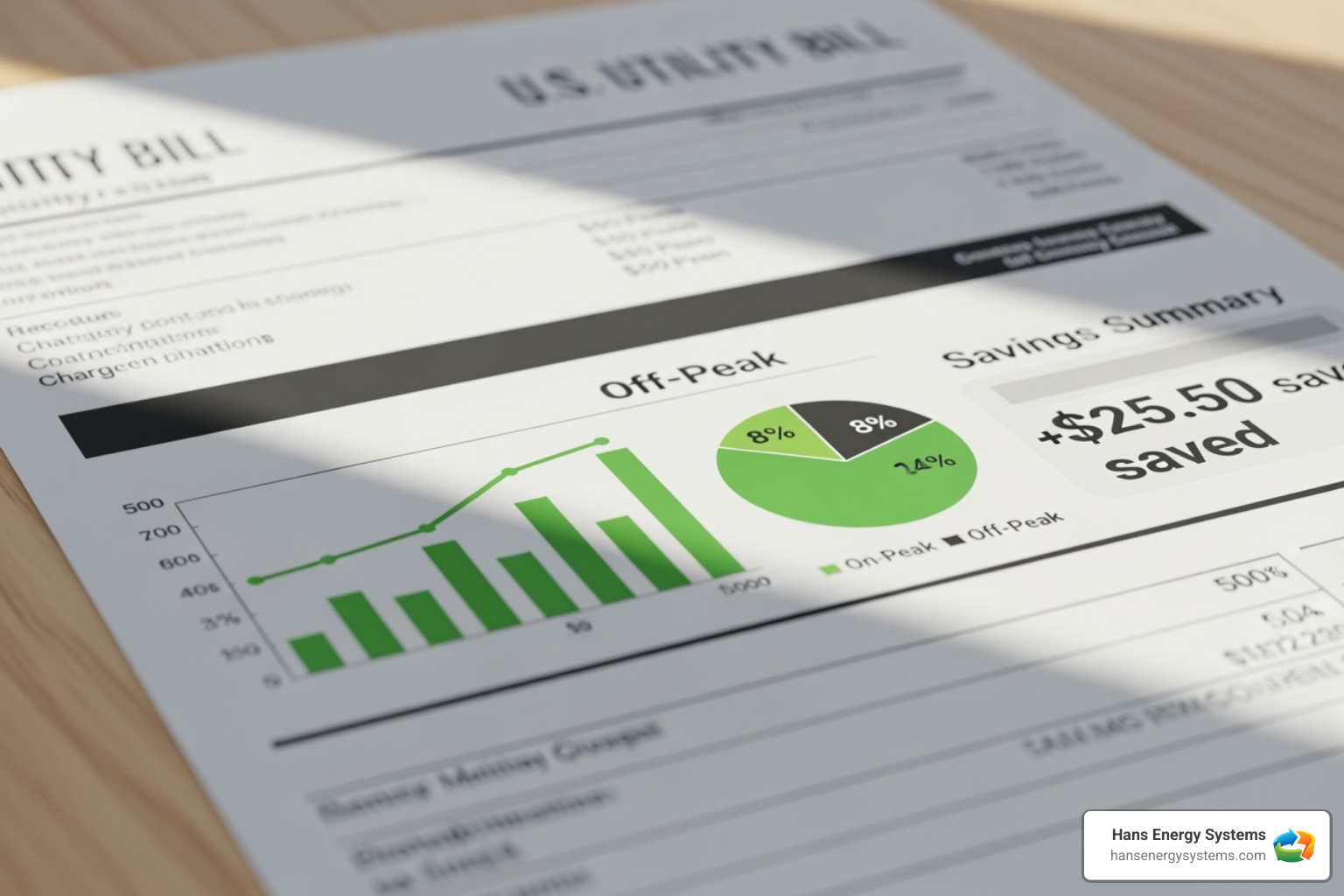
Federal, State, and Utility Incentives
Here’s where things get really exciting – there are multiple programs designed to help offset your installation costs. These incentives can significantly reduce your investment, making home charging even more attractive.
The federal tax credit offers substantial savings through the U.S. Department of Energy’s alternative fuel vehicle refueling property credit. This covers 30% of your total costs (equipment plus installation) up to $1,000 maximum. It’s essentially the government helping you upgrade your home for cleaner transportation. You can Learn more about the federal credit from the U.S Department of Energy.
State rebates vary widely but can provide additional savings on top of federal incentives. Many states offer their own programs through energy or environmental agencies, recognizing that home charging infrastructure benefits everyone by reducing emissions and grid demand during peak hours.
Local utility programs often provide the most immediate savings through direct rebates. Companies like PG&E and Xcel Energy offer rebates for qualified customers installing EV charging equipment. These programs recognize that home charging reduces strain on the electrical grid compared to everyone rushing to public chargers during peak times.
Your local utility might have similar programs, so it’s worth calling them when you’re planning your installation. These incentives can stack with federal and state programs, potentially covering a significant portion of your tesla model 3 home charger installation costs.
The combination of immediate rebates, tax credits, and long-term charging savings makes home charging installation one of the most financially rewarding home improvements you can make.
Maximizing Your Home Charging Experience
Once your tesla model 3 home charger installation is complete, you’re in for a treat! The real magic happens when you start using all the smart features that make home charging feel effortless and incredibly convenient.
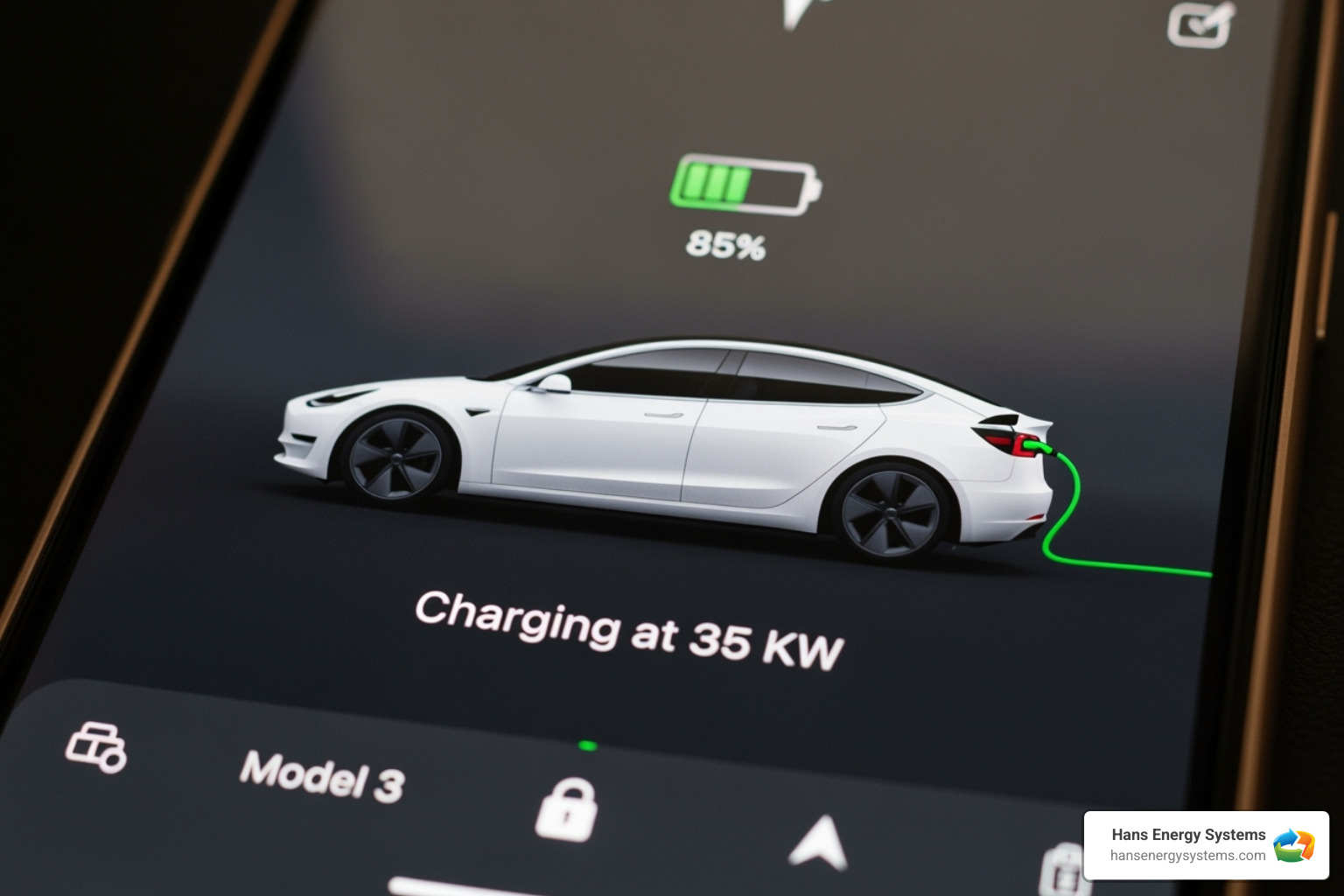
Tesla app integration transforms your smartphone into mission control for your charging experience. With a Wi-Fi-connected Wall Connector, you can monitor your charging status in real-time, check how much energy you’ve used, and even get alerts when charging is complete. It’s like having a personal charging assistant in your pocket.
The scheduled charging feature is where the real savings kick in. Most utility companies charge less for electricity during off-peak hours – usually overnight when demand is lower. You can set your Tesla to automatically start charging during these cheaper periods through either the Tesla app or your car’s touchscreen. Simply plug in when you get home, and your car will patiently wait until rates drop before beginning its charge. You’ll wake up to a full battery without paying premium prices.
Monitoring your energy usage becomes surprisingly interesting once you start tracking it. The app shows exactly how much electricity your Tesla consumes, helping you understand your charging patterns and optimize for maximum savings. Many owners find themselves becoming more conscious of their overall energy use once they see the data.
For Wall Connector owners, access control lets you decide which Tesla vehicles can use your charger. This is perfect if you have multiple EVs in the family or want to prevent unauthorized use. You can manage these settings through the commissioning wizard or directly in the Tesla app.
Integrating with Solar for Ultimate Savings
Here’s where things get really exciting – combining your tesla model 3 home charger installation with solar panels creates the ultimate clean energy setup. You’re essentially driving on sunshine!
Charging with clean energy means every mile you drive is powered by renewable energy from your own roof. It’s an incredible feeling knowing your daily commute isn’t contributing to emissions. Plus, you’re completely insulated from rising gas prices and even electricity rate increases.
Maximizing your solar investment becomes much easier when you have an EV to charge. Those sunny afternoons when your panels are producing more electricity than your home can use? Instead of just sending that excess back to the grid for credits, you can store it in your Tesla’s battery. This means more of your self-generated power stays with your family.
The combination works even better with energy storage solutions. A home battery system lets you capture excess solar energy during the day and use it to charge your Tesla at night. This setup can virtually eliminate your reliance on grid electricity for transportation. We explore this fascinating topic in detail on our Charging Tesla with Solar Panels in Poway, CA page and discuss comprehensive Energy Storage Solutions for Solar Systems.
While the Wall Connector doesn’t directly communicate with your solar system, smart apps can bridge this gap. These applications monitor your solar production and automatically schedule charging when your panels are generating the most power, ensuring you’re truly driving on sunshine.
Frequently Asked Questions about Tesla Home Charging
We’ve helped countless homeowners with their tesla model 3 home charger installation. Here are answers to the most common questions to help you feel confident about your home charging journey.
Can I install a Tesla charger if I live in an apartment or condo?
Yes. While more complex than in a single-family home, many apartment and condo residents successfully install EV chargers. The key is the right approach.
Your first step is having a friendly conversation with your property manager or HOA board. Many are becoming more open to EV charging installations as they realize it increases property value and attracts quality tenants. Some states even have laws requiring reasonable accommodation for EV charging requests.
Tesla makes this easier by providing professional request templates that explain the benefits and installation process. You can download their Request for approval to self-install EV charging in your deeded parking space to help make your case.
Here’s the exciting part – incentives may be available for multi-unit dwellings. Many utility companies and state programs specifically target apartments and condos with rebates and grants for EV charging infrastructure. This can help offset costs for your building management, making them more likely to say yes.
What is the warranty on Tesla charging equipment?
Tesla stands behind their charging equipment with solid warranty coverage that gives you peace of mind with your tesla model 3 home charger installation.
The Wall Connector comes with a 48-month warranty for residential use – that’s four full years of coverage. The Mobile Connector has a 12-month warranty, but here’s a nice bonus: if it was included with your vehicle purchase, that warranty extends to 48 months too.
Both warranties begin from the date of your invoice, and Tesla’s customer service is known for being responsive when warranty issues arise. This coverage protects your investment and ensures you’ll have reliable home charging for years to come.
How does home charging compare to using a Boostr?
Home charging is your daily solution. It’s convenient and significantly cheaper than public charging—often 3-5 times less, especially during off-peak hours. You simply plug in when you get home and let your Tesla charge overnight.
Level 2 AC home charging is also better for daily battery health. Slower, consistent charging puts less stress on your battery than the rapid DC charging at Boostrs. This helps preserve your battery’s longevity.
Supercharging is designed for long-distance travel. When you’re on a road trip and need to add 200+ miles of range in 30 minutes, Boostrs are absolutely fantastic. They’re fast, reliable, and strategically located along major highways. But they come at a premium price because the infrastructure is much more expensive to build and maintain.
For most Tesla owners, the sweet spot is using home charging for 90% of their needs and Supercharging for those longer adventures. This approach maximizes convenience, minimizes costs, and keeps your battery healthy for the long haul.
The bottom line? Home charging handles your daily driving needs perfectly, while Supercharging is there when you need to travel far from home. Together, they make Tesla ownership incredibly convenient and cost-effective.
Your Partner for a Seamless Installation
Investing in a tesla model 3 home charger installation is truly the key to open uping the full convenience and cost-saving potential of your Tesla Model 3 or Y. Think of it as the final piece of the puzzle that transforms your EV ownership experience from good to absolutely fantastic.
When you choose professional installation, you’re not just getting someone to mount a charger on your wall. You’re getting safety assurance through proper electrical work, code compliance that protects your home and family, and optimal performance that ensures your charging equipment works flawlessly for years to come.
At Hans Energy Systems, we understand that your home is more than just a place to park your Tesla – it’s your personal energy ecosystem. As experts in both HVAC and solar energy solutions, we see the bigger picture of how your charging setup fits into your overall energy needs. Whether you’re already enjoying the benefits of solar panels or considering adding them to maximize your EV savings, we’re here to help everything work together seamlessly.
Our team takes pride in treating every tesla model 3 home charger installation with the same care and attention we’d want for our own homes. We know that exceptional customer service means more than just showing up on time (though we do that too!). It means listening to your specific needs, explaining the process clearly, and making sure you feel confident about every step.
The technical details of electrical work can feel overwhelming, and honestly, they should be left to the professionals. Our certified electricians will assess your home’s electrical capacity, determine the best placement for your charger, handle all the permitting paperwork, and ensure your new charging setup integrates perfectly with your existing systems.
We’re your neighbors here in San Diego County, and we’re committed to making your transition to home charging as smooth and stress-free as possible. From the initial assessment to the final testing of your new charger, we’ll be there to guide you through the entire process.
Ready to wake up every morning to a fully charged Tesla? Ready to skip the gas stations forever and enjoy the ultimate convenience of home charging? Request a Custom Quote for your Tesla Wall Charger Installation today and let’s get started on changing your daily routine!



